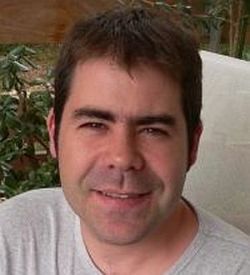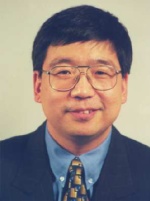



INVITED SPEAKERS
| Pierre Alliez | Hong Qin | Isabelle Magnin |
Pierre Alliez |
|
|
Pierre Alliez received a PhD from the "Ecole Nationale Supérieure des Télécommunications" (ENST) in Paris in 2000, on the topic of geometry compression. He then joined the University of Southern California in Los Angeles and started working with Mathieu Desbrun as a post doc. He was hired by INRIA in Sophia-Antipolis in 2002 in the GEOMETRICA research team, specialized in Geometric Computing. His research interests are on topics commonly referred to as Geometry Processing: geometry compression, surface approximation, mesh parameterization, surface remeshing and mesh generation. Pierre Alliez has received the EuroGraphics Young Researcher Award 2005 in recognition of his contribution to Computer Graphics and Geometry Processing.
For more details: |

|
Invited talk: Variational Shape ReconstructionWednesday, June 13, 9:30-10:30In this talk I will present an algorithm for reconstructing watertight surfaces from unoriented point sets. Using the Voronoi diagram of the input point set, we deduce a tensor field whose principal axes and eccentricities locally represent respectively the most likely direction of the normal to the surface, and the confidence in this direction estimation. An implicit function is then computed by solving a generalized eigenvalue problem such that its gradient is most aligned with the principal axes of the tensor field, providing a best-fitting isosurface reconstruction. This approach possesses a number of distinguishing features. In particular, the implicit function optimization provides resilience to noise, adjustable fitting to the data, and controllable smoothness of the reconstructed surface. |
|
Hong Qin |
|
|
At present, Dr. Hong Qin is a full professor of Computer Science in Department of Computer Science at State University of New York at Stony Brook (Stony Brook University). He received his B.S. degree and his M.S. degree in Computer Science from Peking University in Beijing, China. He received his Ph.D. (1995) degree in Computer Science from the University of Toronto. During his years at the University of Toronto (UofT), he received UofT Open Doctoral Fellowship. He was also a recipient of NSF CAREER Award from the National Science Foundation (NSF), Honda Initiation Award, and Alfred P. Sloan Research Fellow by the Sloan Foundation. In 2005, Professor Qin served as the general Co-Chair for Computer Graphics International 2005 (CGI'2005). Currently, he is an associate editor for IEEE Transactions on Visualization and Computer Graphics (IEEE TVCG), and he is also on the editorial board of The Visual Computer (International Journal of Computer Graphics). In 2007, he is the Conference Co-Chair for ACM Solid and Physical Modeling Symposium. His research interests include geometric and solid modeling, graphics, physics-based modeling and simulation, computer aided geometric design, human-computer interaction, visualization, and scientific computing.
For more details: |

|
Invited talk: Manifold Splines: From Points to Surfaces of Arbitrary TopologyThursday, June 14, 13:30-14:30Constructing polynomial-based, piecewise spline functions whose parametric domain is an arbitrary manifold and effectively computing such splines in real-world engineering and digital entertainment applications are of fundamental significance in shape modeling and computing, engineering design, interactive graphics, etc. In this presentation, I will articulate a general theoretical and computational framework for shape modeling, in which spline surfaces defined over planar domains can be systematically extended to manifold domains of arbitrary topology (with or without boundaries). Our theoretical contribution is on the existence of an affine structure of domain manifolds for the proper definition of manifold splines. After motivating the research objectives and highlighting our theoretical contributions, I will discuss a set of practical algorithmic tools to generalize triangular B-spline surfaces from planar domains to manifold domains. Consequently, our new spline surface defined over any manifold is a piecewise polynomial surface with high parametric continuity without the need for any patching and/or trimming operations. Throughout the talk, I will show various modeling examples, with a special emphasis on reverse engineering, data fitting, interpolation of points and their normals, shape fairing and analysis, editing and deformation, shape segmentation, and medical imaging applications. It is my hope that this talk could demonstrate that our novel manifold splines are both powerful and efficient in shape modeling and computing, interactive graphics, simulation, visualization, analysis, and engineering design. |
|
Isabelle Magnin |
|
|
Pr. Isabelle E. Magnin heads the CREATIS-Lrmn Lab. (Centre of Research and Applications in Signal and Image Processing) devoted to medical imaging, in Lyon France. She belongs to numerous national, european and international scientific boards. She is an Honorary Professor of the Harbin University in China. Her research interest is Medical Image Processing including tomography, motion estimation, analysis and modelling of 2D and 3D deformable objects from multimodal medical image sequences (CT, MRI, US, PET). Since 2000, she promoted biomedical image processing applications (Cardiac imaging and MRI simulation) in European Healthgrid Projects. In 1994, she got the Gold medal for innovation from the European Society of Non Destructive Testing for original work in ultrasonic image processing. She is the author of about 230 publications.
For more details:
|

|
Invited talk: 3D shape modeling of vessels and beating heart using generalized cylinders and deformable meshesFriday, June 15, 09:00-10:00 |
|